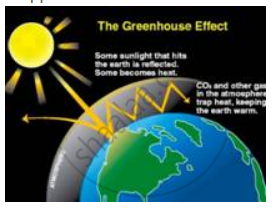Advertisements
Advertisements
प्रश्न
Our atmosphere acts as a greenhouse. Explain.
उत्तर
Our atmosphere contains greenhouse gases such as CO2, water vapour, O3, CH4, oxides of nitrogen and CFCs and allows the sun rays to come in. Sunlight reaching the Earth consists of three types of radiation-UV radiation, visible radiation, and IR radiation. As sunlight passes through the atmosphere, most UV radiation is absorbed by ozone; 30% of IR radiation reaches the Earth's surface, heating it up. As the Earth's surface becomes hot, it starts emitting radiation with less energy than the incoming radiation and thus with a longer wavelength. Some emitted IR radiation escapes from the Earth's surface and some is absorbed by CO2, thus remaining on the Earth. Trapped radiation warms the Earth's surface and lower layers of the atmosphere.

APPEARS IN
संबंधित प्रश्न
What are their harmful effects?
State the main sources and effects of carbon monoxide.
Explain the formation of acid rain due to:
Oxides of nitrogen
Explain the effect of sulphur dioxide on the atmosphere.
Fill in the blank:
Excessive release of carbon dioxide in the atmosphere is the cause of __________ effect which produces global warming.
Fill in the blank:
The decrease in the concentration of ozone in the stratosphere is the cause of the formation of __________ holes.
Select the correct answer:
A decrease in the amount of ozone in the stratosphere is called depletion of the zone and it is caused by
What is the effect of the following pollutants on living beings?
Smoke particles
How do you propose to control:
Carbon monoxide emission
State why natural rain water produced in an unpolluted atmosphere is slightly acidic. Give a balanced equation of the same.
